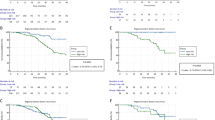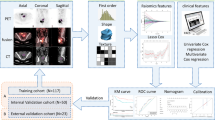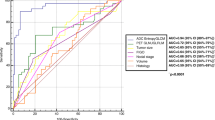Abstract
Purpose
To develop machine learning models to predict para-aortic lymph node (PALN) involvement in patients with locally advanced cervical cancer (LACC) before chemoradiotherapy (CRT) using 18F-FDG PET/CT and MRI radiomics combined with clinical parameters.
Methods
We retrospectively collected 178 patients (60% for training and 40% for testing) in 2 centers and 61 patients corresponding to 2 further external testing cohorts with LACC between 2010 to 2022 and who had undergone pretreatment analog or digital 18F-FDG PET/CT, pelvic MRI and surgical PALN staging. Only primary tumor volumes were delineated. Radiomics features were extracted using the Radiomics toolbox®. The ComBat harmonization method was applied to reduce the batch effect between centers. Different prediction models were trained using a neural network approach with either clinical, radiomics or combined models. They were then evaluated on the testing and external validation sets and compared.
Results
In the training set (n = 102), the clinical model achieved a good prediction of the risk of PALN involvement with a C-statistic of 0.80 (95% CI 0.71, 0.87). However, it performed in the testing (n = 76) and external testing sets (n = 30 and n = 31) with C-statistics of only 0.57 to 0.67 (95% CI 0.36, 0.83). The ComBat-radiomic (GLDZM_HISDE_PET_FBN64 and Shape_maxDiameter2D3_PET_FBW0.25) and ComBat-combined (FIGO 2018 and same radiomics features) models achieved very high predictive ability in the training set and both models kept the same performance in the testing sets, with C-statistics from 0.88 to 0.96 (95% CI 0.76, 1.00) and 0.85 to 0.92 (95% CI 0.75, 0.99), respectively.
Conclusions
Radiomic features extracted from pre-CRT analog and digital 18F-FDG PET/CT outperform clinical parameters in the decision to perform a para-aortic node staging or an extended field irradiation to PALN. Prospective validation of our models should now be carried out.








Similar content being viewed by others
Data availability
The datasets generated during and/or analyzed during the current study are available from the corresponding author on reasonable request.
References
Cibula D, Pötter R, Planchamp F, Avall-Lundqvist E, Fischerova D, Haie Meder C, et al. The European Society of Gynaecological Oncology/European Society for Radiotherapy and Oncology/European Society of Pathology guidelines for the management of patients with cervical cancer. Radiother Oncol. 2018;127:404–16.
Frumovitz M, Querleu D, Gil-Moreno A, Morice P, Jhingran A, Munsell MF, et al. Lymphadenectomy in locally advanced cervical cancer study (LiLACS): Phase III clinical trial comparing surgical with radiologic staging in patients with stages IB2-IVA cervical cancer. J Minim Invasive Gynecol. 2014;21:3–8.
Thelissen AAB, Jürgenliemk-Schulz IM, van der Leij F, Peters M, Gerestein CG, Zweemer RP, et al. Upstaging by para-aortic lymph node dissection in patients with locally advanced cervical cancer: a systematic review and meta-analysis. Gynecol Oncol. 2022;164:667–74.
Gouy S, Morice P, Narducci F, Uzan C, Gilmore J, Kolesnikov-Gauthier H, et al. Nodal-staging surgery for locally advanced cervical cancer in the era of PET. Lancet Oncol. 2012;13:e212-220.
Cibula D, Borčinová M, Marnitz S, Jarkovský J, Klát J, Pilka R, et al. Lower-limb lymphedema after sentinel lymph node biopsy in cervical cancer patients. Cancers (Basel). 2021;13:2360.
Nasioudis D, Rush M, Taunk NK, Ko EM, Haggerty AF, Cory L, et al. Oncologic outcomes of surgical para-aortic lymph node staging in patients with advanced cervical carcinoma undergoing chemoradiation. Int J Gynecol Cancer. 2022;32:823–7.
Dabi Y, Simon V, Carcopino X, Bendifallah S, Ouldamer L, Lavoue V, et al. Therapeutic value of surgical paraaortic staging in locally advanced cervical cancer: a multicenter cohort analysis from the FRANCOGYN study group. J Transl Med. 2018;16:326.
Nguyen-Xuan HT, Benoit L, Dabi Y, Touboul C, Raimond E, Ballester M, et al. How to predict para-aortic node involvement in advanced cervical cancer? Development of a predictive score. A FRANCOGYN study. Eur J Surg Oncol. 2021;47:2900–6.
Lucia F, Visvikis D, Vallières M, Desseroit M-C, Miranda O, Robin P, et al. External validation of a combined PET and MRI radiomics model for prediction of recurrence in cervical cancer patients treated with chemoradiotherapy. Eur J Nucl Med Mol Imaging. 2019;46:864–77.
Ferreira M, Lovinfosse P, Hermesse J, Decuypere M, Rousseau C, Lucia F, et al. [18F]FDG PET radiomics to predict disease-free survival in cervical cancer: a multi-scanner/center study with external validation. Eur J Nucl Med Mol Imaging. 2021;48:3432–43.
Li K, Sun H, Lu Z, Xin J, Zhang L, Guo Y, et al. Value of [18F]FDG PET radiomic features and VEGF expression in predicting pelvic lymphatic metastasis and their potential relationship in early-stage cervical squamous cell carcinoma. Eur J Radiol. 2018;106:160–6.
Li L, Zhang J, Zhe X, Tang M, Zhang X, Lei X, et al. A meta-analysis of MRI-based radiomic features for predicting lymph node metastasis in patients with cervical cancer. Eur J Radiol. 2022;151: 110243.
Li X-R, Jin J-J, Yu Y, Wang X-H, Guo Y, Sun H-Z. PET-CT radiomics by integrating primary tumor and peritumoral areas predicts E-cadherin expression and correlates with pelvic lymph node metastasis in early-stage cervical cancer. Eur Radiol. 2021;31:5967–79.
Dong T, Yang C, Cui B, Zhang T, Sun X, Song K, et al. Development and validation of a deep learning radiomics model predicting lymph node status in operable cervical cancer. Front Oncol. 2020;10:464.
Chen J, He B, Dong D, Liu P, Duan H, Li W, et al. Noninvasive CT radiomic model for preoperative prediction of lymph node metastasis in early cervical carcinoma. Br J Radiol. 2020;93:20190558.
Yasaka K, Akai H, Abe O, Kiryu S. Deep learning with convolutional neural network for differentiation of liver masses at dynamic contrast-enhanced CT: a preliminary study. Radiology. 2018;286:887–96.
Opitz D, Maclin R. Popular ensemble methods: an empirical study. jair. 1999;11:169–98.
Bourbonne V, Lucia F, Jaouen V, Bert J, Rehn M, Pradier O, et al. Development and prospective validation of a spatial dose pattern based model predicting acute pulmonary toxicity in patients treated with volumetric arc-therapy for locally advanced lung cancer. Radiother Oncol. 2021;164:43–9.
Delcroix O, Bourhis D, Keromnes N, Robin P, Le Roux P-Y, Abgral R, et al. Assessment of image quality and lesion detectability with digital PET/CT system. Front Med (Lausanne). 2021;8: 629096.
Belli ML, Mori M, Broggi S, Cattaneo GM, Bettinardi V, Dell’Oca I, et al. Quantifying the robustness of [18F]FDG-PET/CT radiomic features with respect to tumor delineation in head and neck and pancreatic cancer patients. Phys Med. 2018;49:105–11.
Velazquez ER, Parmar C, Jermoumi M, Mak RH, van Baardwijk A, Fennessy FM, et al. Volumetric CT-based segmentation of NSCLC using 3D-Slicer. Sci Rep. 2013;3:3529.
Zwanenburg A, Vallières M, Abdalah MA, Aerts HJWL, Andrearczyk V, Apte A, et al. The image biomarker standardization initiative: standardized quantitative radiomics for high-throughput image-based phenotyping. Radiology. 2020;295:328–38.
Fortin J-P, Cullen N, Sheline YI, Taylor WD, Aselcioglu I, Cook PA, et al. Harmonization of cortical thickness measurements across scanners and sites. Neuroimage. 2018;167:104–20.
Gouy S, Morice P, Narducci F, Uzan C, Martinez A, Rey A, et al. Prospective multicenter study evaluating the survival of patients with locally advanced cervical cancer undergoing laparoscopic para-aortic lymphadenectomy before chemoradiotherapy in the era of positron emission tomography imaging. J Clin Oncol. 2013;31:3026–33.
De Cuypere M, Lovinfosse P, Goffin F, Gennigens C, Rovira R, Duch J, et al. Added value of para-aortic surgical staging compared to 18F-FDG PET/CT on the external beam radiation field for patients with locally advanced cervical cancer: an ONCO-GF study. Eur J Surg Oncol. 2020;46:883–7.
Gouy S, Seebacher V, Chargari C, Terroir M, Grimaldi S, Ilenko A, et al. False negative rate at 18F-FDG PET/CT in para-aortic lymphnode involvement in patients with locally advanced cervical cancer: impact of PET technology. BMC Cancer. 2021;21:135.
Smits RM, Zusterzeel PLM, Bekkers RLM. Pretreatment retroperitoneal para-aortic lymph node staging in advanced cervical cancer: a review. Int J Gynecol Cancer. 2014;24:973–83.
Martinez A, Voglimacci M, Lusque A, Ducassou A, Gladieff L, Dupuis N, et al. Tumour and pelvic lymph node metabolic activity on FDG-PET/CT to stratify patients for para-aortic surgical staging in locally advanced cervical cancer. Eur J Nucl Med Mol Imaging. 2020;47:1252–60.
Leithner D, Schöder H, Haug A, Vargas HA, Gibbs P, Häggström I, et al. Impact of ComBat harmonization on PET radiomics-based tissue classification: a dual-center PET/MRI and PET/CT Study. J Nucl Med. 2022;63:1611–6.
Becker AS, Wagner MW, Wurnig MC, Boss A. Diffusion-weighted imaging of the abdomen: impact of b-values on texture analysis features. NMR Biomed. 2017;30(1). https://doi.org/10.1002/nbm.3669.
Hatt M, Cheze Le Rest C, Antonorsi N, Tixier F, Tankyevych O, Jaouen V, et al. Radiomics in PET/CT: current status and future AI-based evolutions. Semin Nucl Med. 2021;51:126–33.
Duda RO, Hart EP, Stork DG. Pattern classification. 2nd ed. 1973. https://www.researchgate.net/publication/228058014_Pattern_Classification.
Hatt M, Tixier F, Pierce L, Kinahan PE, Le Rest CC, Visvikis D. Characterization of PET/CT images using texture analysis: the past, the present… any future? Eur J Nucl Med Mol Imaging. 2017;44:151–65.
Heus P, Damen JAAG, Pajouheshnia R, Scholten RJPM, Reitsma JB, Collins GS, et al. Uniformity in measuring adherence to reporting guidelines: the example of TRIPOD for assessing completeness of reporting of prediction model studies. BMJ Open. 2019;9: e025611.
Funding
The authors declare that no funds, grants, or other support were received during the preparation of this manuscript.
Author information
Authors and Affiliations
Contributions
All authors contributed to the study conception and design. Material preparation, data collection, and analysis were performed by François Lucia, Vincent Bourbonne, Clémence Pleyers, Mathieu Hatt, Roland Hustinx, and Pierre Lovinfosse. The first draft of the manuscript was written by François Lucia and Pierre Lovinfosse and all authors commented on previous versions of the manuscript. All authors read and approved the final manuscript.
Corresponding author
Ethics declarations
Ethics approval
All procedures were performed in accordance with the principles of the 1964 Declaration of Helsinki and its later amendments or comparable ethical standards. The study design and exemption from informed consent were approved by the Institutional Review Board of Liege University Hospital.
Consent to participate
The study design and exemption from informed consent were approved by the Institutional Review Board of Liege University Hospital.
Competing interests
The authors declare that they have no competing interests.
Additional information
Publisher's note
Springer Nature remains neutral with regard to jurisdictional claims in published maps and institutional affiliations.
This article is part of the Topical Collection on Advanced Image Analyses (Radiomics and Artificial Intelligence)
Supplementary Information
Below is the link to the electronic supplementary material.
Rights and permissions
Springer Nature or its licensor (e.g. a society or other partner) holds exclusive rights to this article under a publishing agreement with the author(s) or other rightsholder(s); author self-archiving of the accepted manuscript version of this article is solely governed by the terms of such publishing agreement and applicable law.
About this article
Cite this article
Lucia, F., Bourbonne, V., Pleyers, C. et al. Multicentric development and evaluation of 18F-FDG PET/CT and MRI radiomics models to predict para-aortic lymph node involvement in locally advanced cervical cancer. Eur J Nucl Med Mol Imaging 50, 2514–2528 (2023). https://doi.org/10.1007/s00259-023-06180-w
Received:
Accepted:
Published:
Issue Date:
DOI: https://doi.org/10.1007/s00259-023-06180-w




